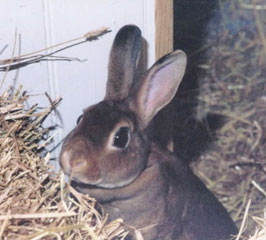August
2005
Wanted:
Outgoing Vegetarian to Share Uptown Loft
By Mark Hawthorne
|
 |
Maeve. Photo by Mark
Hawthorne |
Maeve, a young Mini Rex rabbit, sensed something was
amiss in the Manhattan apartment. In the pre-dawn stillness, she could
hear water leaking
in the bathroom. But Dave Troy, her guardian, was asleep. So Maeve
did what bunnies do when they detect a threat: she used her powerful
hind legs to thump the floor. Repeatedly. “She continued banging
until I got out of bed,” recalls Troy. “It was a burst
pipe, and water was coming from the ceiling. Not very loudly, but she
knew something wasn’t right.” Another disaster averted
by rabbit intervention—and one of many examples of the special
relationship humans enjoy with their long-eared friends, even in the
city.
It hasn’t always been so. Only in the last few decades have we widely recognized
the unique, loving natures of domestic rabbits and brought them indoors from
backyard hutches and cages to become members of the family. Safe from predators
and inclement weather, these “house rabbits” form deep bonds with
humans. They flourish in any type of dwelling, making them especially suited
for the high-density housing found in cities. Unlike dogs and cats—predatory
animals for whom venturing outdoors might answer any calls of nature—rabbits
are quite content with a room or two.
“Rabbits are a great urban pet because they do not have the timetable restrictions
that dogs or cats have,” says Chicago resident Craig Youngberg. “As
they graze all day long, we leave enough food out in the morning so we do not
have to be home at a specific time to feed them dinner.” People have many
misconceptions about rabbits though, which can dissuade them from bringing a
bunny into their home. Many people, for example, are surprised to learn that
rabbits will use a litterbox. Indeed, bunnies are extremely clean animals who
regularly groom themselves and each other.
“I think that if rabbits were better understood they would become the most
popular urban pet,” says Brian Zulauf, who shares an apartment with two
rabbits in Portland, Oregon. “They have all of the good qualities of a
cat, but don’t make noise. They are most active in the morning and evening
when people are home from work. Most of their bad reputation is the result of
improper care from humans.” Proper care includes spaying or neutering the
rabbit. Not only is this vital for the rabbit’s health, but it helps keep
the bunny population in check and dramatically reduces unpleasant behavioral
traits, like marking with urine, digging, and the fighting associated with sexual
aggression.
Nothing, however, will keep a bunny from indulging one of his most fundamental
instincts: chewing. This can be especially stressful for renters, since they
are prohibited from making alterations to their dwellings. It helps to offer
the rabbit safe things to chew, like untreated pine, phone books, or rabbit toys.
And you’ll need to ensure that the bunny cannot reach electrical wiring,
cords, houseplants, and books on lower shelves. “Rabbits love baseboards,” says
Judy Hardin, whose five bunnies essentially have the run of her Berkeley apartment.
After experimenting with a few solutions, she now sprays inexpensive perfume
along the wood every couple of months, which prevents them from chewing it. Hardin
understands that a bored bunny is a naughty bunny. “So, they get new toys
every day in a rotation system that is roughly one new toy every 10 days or so.
I introduce a brand-new toy about every 30 days and retire an old one to their
toy box.”
Keeping a rabbit safe indoors also means taking extra care in hot weather, which
can lead to heatstroke. While wild rabbits can burrow underground for relief,
house rabbits rely on their guardians when the mercury rises. This can be a challenge
in some cities, where living spaces might not have air conditioning or when an
oscillating fan isn’t sufficient. “I live on the top floor where
the temperature in the apartment in the summer is hotter than outside,” says
Zulauf. His solution is a portable air conditioner, which cost about $300 and
will keep one room cool. Adequate ventilation and fresh drinking water are essential.
Rabbits also love to lie beside a bottle filled with frozen water to beat the
heat.
If you rent, do not accept the adage that it’s easier to ask forgiveness
than permission. “Get your landlord’s approval before bringing home
a rabbit,” says Marcy Schaaf, who manages the House Rabbit Society’s
San Francisco/Marin chapter (www.saveabunny.com). “Don’t risk having
to give up a bunny you’ve bonded with.” Schaaf also recommends that
urbanites have reliable transportation to a veterinarian who treats rabbits.
Whether you live in a high-rise building or country estate, if you decide a rabbit
is right for you, adopt one from a local animal shelter or the House Rabbit Society
rather than buying one. You’ll save a life and discourage rabbit breeding.
We’ve come a long way in appreciating these fun-loving creatures, and they
deserve to be valued as individuals, not a spontaneous pet store purchase relegated
to an outdoor cage. Perhaps Dave Troy sums them up best. “Rabbits are playful,
affectionate, loyal, and very smart,” he says. “They are wonderful
companions.” I’m sure Maeve agrees.
To learn more, see www.rabbit.org.
 |
|
|
 |

